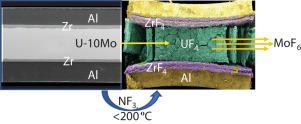Journal of Fluorine Chemistry ( IF 1.7 ) Pub Date : 2020-05-14 , DOI: 10.1016/j.jfluchem.2020.109539 B.K. McNamara , A.M. Casella , E.C. Buck , R.A. Clark , I.J. Schwerdt , R.G. Surbella III , K.M. McCoy

|
A single step separation of molybdenum from a multicomponent uranium alloy, 10 wt% Mo in uranium metal, (U-10Mo)-Zr is explored using nitrogen trifluoride. The separation takes advantage of an unusually low temperature behavior of NF3. Exposure of the alloy to flowing NF3 between 100 to 200 °C caused surface area dependent, NF3 concentration, and temperature dependent thermal runaway that threatened the viability of the separation. Gravimetric methods were used to acquire temperature and NF3 concentration dependent profiles to understand the nature of the self-heating and to establish practical conditions for the separation. Scale-up to multigram quantities of the composite is described. In this effort, the use of larger product masses helped to divulge potential metal/MoF6 redox behavior of during the fluorination and acknowledgement of some unexpected chemistries as the metals evolved from the metallic state to their higher fluorides in the presence of what appears to be a catalytic or otherwise activated NF3-uranium metal surface.
中文翻译:

利用氟化物挥发性有针对性地从复杂合金中回收铀
使用三氟化氮探索了从多组分铀合金(铀金属中的10 wt%Mo(U-10Mo)-Zr)中分离钼的步骤。分离利用了NF 3异常低温的优势。合金暴露于100至200°C的流动NF 3中会导致表面积依赖性,NF 3浓度和温度依赖性热失控,从而威胁到分离的可行性。重量法用于获取温度和NF 3浓度依赖性曲线,以了解自热的性质并建立分离的实际条件。描述了按比例放大至复合材料的克数。在这项工作中,使用较大的产品质量有助于在氟化过程中泄露潜在的金属/ MoF 6氧化还原行为,并认可了一些意外的化学反应,因为金属在似乎存在的情况下从金属态演变成其较高的氟化物。催化或活化的NF 3-铀金属表面。









































 京公网安备 11010802027423号
京公网安备 11010802027423号